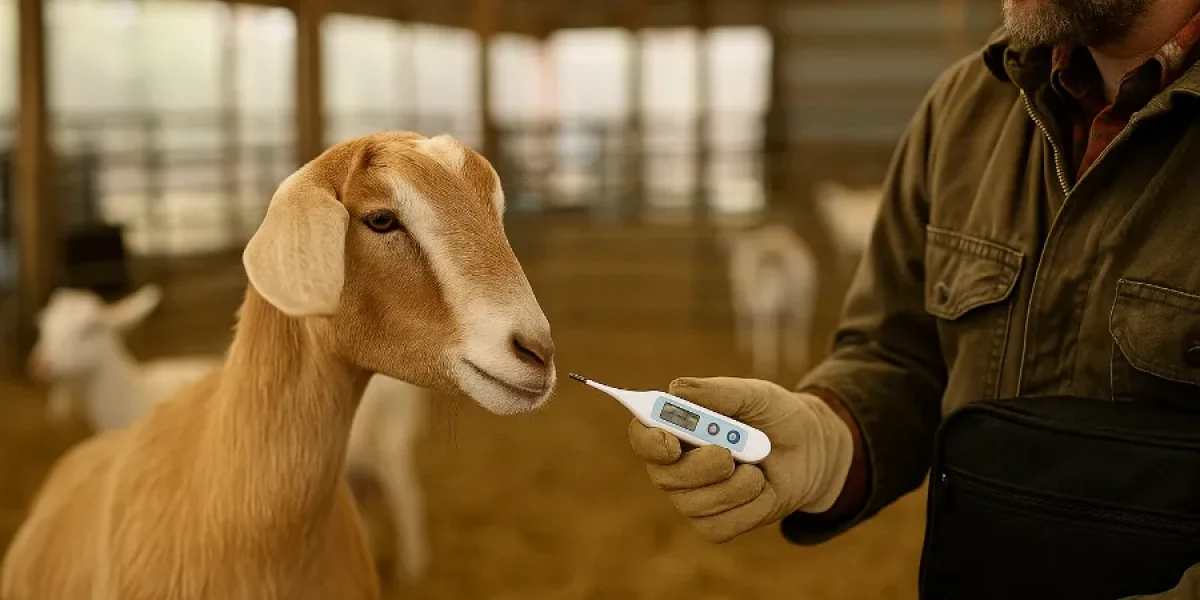If you’ve ever raised goats for more than a season, you’ve probably had one moment that taught you how important it is to understand goat temperature. For me, it was a chilly morning when one of my twin kids stopped nursing and just wouldn’t get up. Her temperature had dropped to 99°F — dangerously low for a baby goat. That experience forever changed how I manage my herd.
Understanding goat temperature and what’s normal isn’t just about numbers. It’s about recognizing what those numbers mean — for health, comfort, and survival. A normal adult goat temperature should sit between 101.5°F and 103.5°F (38.6°C–39.7°C), while kids can run slightly higher, up to 104°F. Anything outside that range tells you the body is fighting stress, weather, diet, or disease.
Let’s dive into what affects temperature in goats — from natural to biological causes — and how it changes across life stages, from wobbly newborns to hardworking pregnant does.
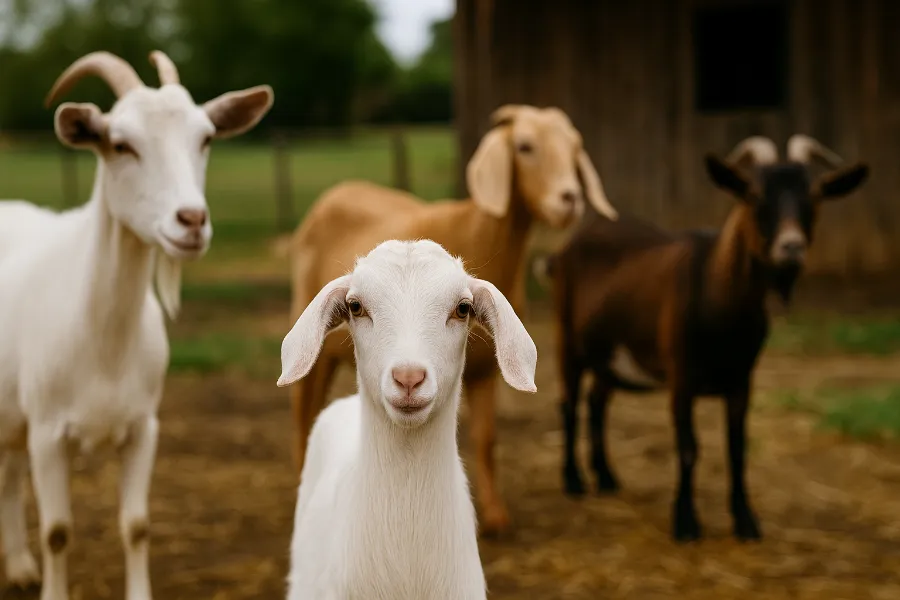
Goat Farming: Why Temperature Monitoring Is a Game-Changer
Running a small herd or a full-scale goat farming operation means learning to “read” your animals beyond appearances. Goats are masters at hiding discomfort. They might still chew cud, walk, and seem alert — even while their temperature signals trouble underneath.
Temperature monitoring gives you insight into:
- Feed or mineral imbalances
- Parasite load
- Disease outbreaks
- Environmental stress (cold snaps, heat waves)
- Reproductive issues in bucks and does
A healthy goat’s internal temperature tells you that their metabolism, digestion, and immune system are in sync. When that balance shifts, temperature changes are usually your first warning.
That’s why a digital thermometer is as essential in goat farming as a good pair of boots. I keep one in my barn kit and log temperatures whenever something feels “off.” It’s a small habit that prevents big losses.
Goat Care: How to Check and Interpret Goat Temperature
Good goat care starts with observation — and no observation is complete without a thermometer reading.
Here’s how I do it on my homestead:
- Gently restrain the goat (a helper is handy).
- Lubricate a digital thermometer with a dab of oil or Vaseline.
- Insert it about an inch into the rectum.
- Wait for the beep, then record the temperature.
- Sanitize the thermometer after every use.
If I find a goat running above 104°F, I assume fever and investigate infection, dehydration, or stress. If it drops below 100°F, especially in kids, I suspect hypothermia, shock, or metabolic imbalance.
Keeping notes helps me spot patterns — like certain goats running warmer in summer or older does dropping slightly after kidding. Over time, you’ll learn what “normal” looks like for your herd.
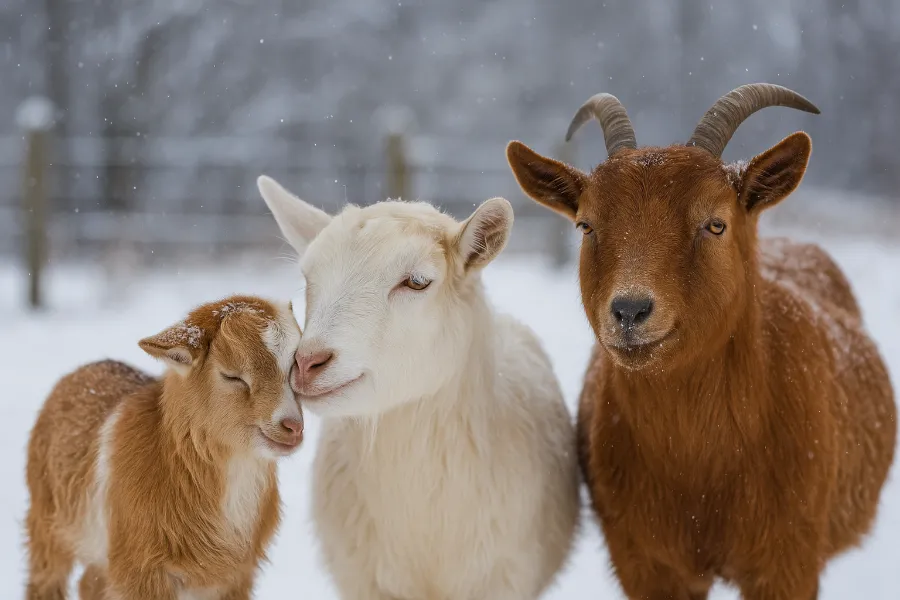
How to Keep Goats Warm in Winter
When winter hits hard, maintaining goat temperature becomes a daily mission. Goats may have thick coats, but they lose body heat fast when bedding is damp or wind sneaks through the barn.
Here’s what I’ve learned about how to keep goats warm in winter without risking ventilation or fire hazards:
- Dry bedding is everything. Deep straw or wood shavings trap warmth and keep hooves dry.
- Draft-free, not airtight. Goats need fresh air to prevent pneumonia, but protect them from direct wind.
- Feed more roughage. The act of digesting hay produces internal heat.
- Keep water unfrozen. Warm water encourages drinking, which supports digestion and warmth.
- Herd body heat helps. Goats huddle together naturally; small groups share warmth effectively.
For baby goats born in winter, I dry them immediately and use heat lamps carefully (always secured high and away from bedding). Even a few degrees of warmth can save a kid’s life.
Goat Disease: When Temperature Becomes the First Warning
Fever or chills are often the first signs of goat disease — long before other symptoms show up.
Here are a few I’ve dealt with on the farm and how they affect temperature:
1. Pneumonia
Caused by cold drafts or sudden weather changes. Temperature spikes to 105°F+, with coughing or labored breathing. It’s urgent — isolate, keep warm, and contact your vet.
2. Mastitis
In lactating does, infection in the udder causes fever, swelling, and clumpy milk. Early temperature checks can save milk supply and prevent permanent damage.
3. Enterotoxemia (Overeating Disease)
Triggered by sudden feed changes or high-grain diets. Fever appears first, followed by lethargy and bloat. Vaccination and slow feed transitions are key.
4. Coccidiosis (Kids)
Young goats often show diarrhea, poor growth, and fever. Stress or dirty pens make it worse — prevention through clean water and coccidia control is crucial.
5. Shock or Hypothermia
A goat with low temperature may be in shock after kidding, injury, or predator attack. Wrap them in blankets, offer electrolytes, and seek help fast.
Temperature is the goat’s silent SOS — it speaks before visible signs of sickness do.
Pregnant Goat: Temperature and Kidding Signs
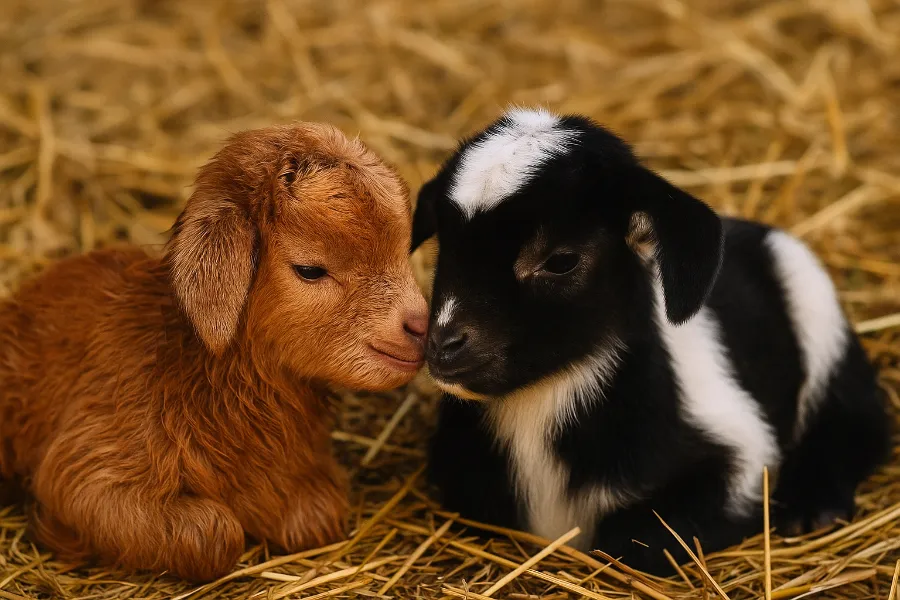
If you’ve ever sat up late waiting for a pregnant goat to kid, you know the thermometer becomes your best friend.
A healthy pregnant doe typically stays around 102°F–103°F. About 12–24 hours before labor, her temperature often drops 1°F. That’s the sign I use to prep the kidding pen and call it a night on the couch nearby.
After kidding, temperature should return to normal quickly. But if it spikes beyond 104°F, I check for:
- Uterine infection (metritis)
- Mastitis
- Retained placenta
If it drops below 100°F, I consider pregnancy toxemia or ketosis, both dangerous metabolic conditions in late gestation. These usually need immediate veterinary help and a boost in energy (like molasses water or propylene glycol).
Temperature trends during pregnancy are more reliable than guessing from behavior alone. When tracked daily, you’ll see the natural rhythm of her body preparing for birth.
Goat Breeding: Managing Heat, Stress, and Fertility
Temperature plays a quiet but crucial role in goat breeding success. Both bucks and does can experience stress-related temperature fluctuations that affect fertility.
For does, mild temperature rises can occur during heat cycles due to hormonal changes. For bucks, high summer temperatures can actually lower sperm quality — so shade and hydration are non-negotiable during the breeding season.
After breeding, I monitor does for unusual fevers, which could mean infection or uterine irritation. I also note bucks’ energy levels and behavior — if they seem overheated or lethargic, it’s usually a hydration issue or mineral imbalance.
Healthy temperature regulation equals better fertility, healthier kids, and smoother breeding cycles. It’s another reason a simple thermometer pays for itself ten times over.
Selenium Deficiency in Goats: The Silent Temperature Problem
If you’ve raised goats long enough, you’ve probably heard of or dealt with selenium deficiency in goats. It’s common in regions with low-selenium soil, and it affects temperature control, muscle strength, and immunity.
Goats low in selenium often appear:
- Weak or shaky
- Cold, even in mild weather
- Slow to nurse or walk (in kids)
- Prone to retained placenta or stillbirth (in does)
Selenium works closely with vitamin E to support muscle and thyroid function — both essential for thermoregulation. When a goat can’t maintain proper muscle tone, it loses heat more easily.
Prevent deficiency with:
- Selenium-enriched loose minerals or blocks
- Vitamin E–selenium gel before kidding
- Selenium-fortified feed mixes
- Veterinary supplementation in extreme cases
I saw a night-and-day difference after introducing mineral blocks with selenium. My kids stopped shivering on mild nights, and birth recovery improved dramatically.
What Causes Temperature Changes in Goats?
Temperature shifts don’t happen randomly — they stem from natural, chemical, biological, and environmental hazards.
Natural Causes
- Seasonal extremes (heat waves, frost)
- Age — kids and seniors can’t regulate heat well
- Hormonal changes — pregnancy, lactation, breeding cycles
- Stress — transport, weaning, or isolation
Chemical or Nutritional Causes
- Moldy or fermented feed causes toxin buildup and fever
- Overfeeding grain triggers rumen acidosis and internal heat
- Pesticide or herbicide exposure leads to chemical fever
- Mineral imbalance (selenium, calcium) interferes with regulation
Biological Causes
- Parasites like barber pole worms drain blood, causing anemia and low temp
- Bacterial infections (mastitis, pneumonia, navel ill) cause fever
- Viral diseases can fluctuate temperature and reduce immunity
Environmental Hazards
- Poor shelter design (dampness, drafts)
- Inadequate shade in hot weather
- Overcrowding or transport stress
- Sudden weather changes without acclimation
Each category affects the body differently — but they all reveal themselves through temperature. That’s why it’s your first line of defense.
Effects of Temperature Changes — From Baby Goats to Pregnant Does
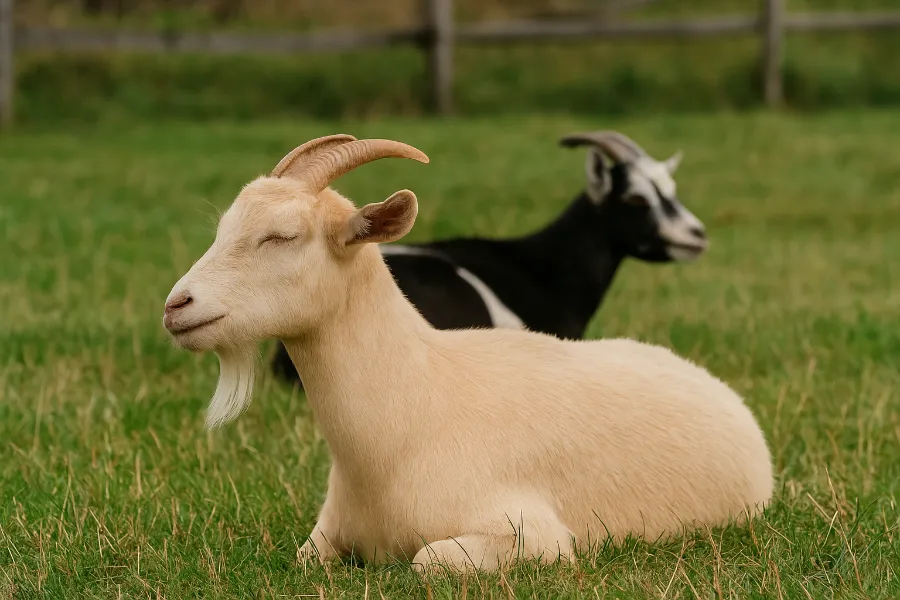
Baby Goats (Kids)
Kids are most vulnerable. A drop below 100°F means immediate action — warm towels, heat lamps, and colostrum once stable. Fever in kids usually points to infection or coccidiosis. Either extreme can turn fatal quickly if ignored.
Adult Goats
Adult goats regulate better but still react to stress, weather, and parasites. Fever above 104°F means fight-or-flight — infection or inflammation is brewing. Low temp below 100°F suggests severe dehydration, shock, or metabolic collapse.
Pregnant and Nursing Does
Pregnant goats walk a metabolic tightrope. Temperature drops signal labor; spikes suggest infection or toxemia. Postpartum fever affects milk flow and kid survival, while low temps indicate exhaustion or nutritional deficits.
Temperature is the one metric that unites all stages of goat life — a thermometer in your pocket can save both kids and seasoned mothers.
Final Thoughts: Reading the Language of Goat Temperature
When you truly learn to interpret goat temperature, you stop reacting and start anticipating. It’s like speaking your herd’s language — each number tells you whether they’re thriving, stressed, or silently struggling.
From mastering how to keep goats warm in winter, to understanding the links between goat disease, pregnant goat care, goat breeding, and even selenium deficiency in goats, temperature monitoring ties everything together.
Whether you’re managing a large-scale goat farming operation or a backyard homestead, this one skill — knowing what’s normal and what’s not — gives you the confidence to step in before small issues turn into emergencies.
The thermometer may be the smallest tool in your kit, but it’s the one that keeps your herd alive, productive, and healthy year-round.
FAQs
A healthy adult goat’s temperature ranges from 101.5°F to 103.5°F (38.6°C–39.7°C). Readings outside this range can signal stress, illness, or environmental imbalance.
Check temperature anytime a goat seems off — not eating, isolating, or acting sluggish. During extreme weather, pregnancy, or illness recovery, daily checks are best.
Common causes include infections like pneumonia, mastitis, or enterotoxemia. Heat stress and poor ventilation can also raise body temperature temporarily.
Low temperature usually indicates hypothermia or shock. Move the goat to a warm, dry area, offer fluids, and monitor closely; call a vet if it doesn’t stabilize.
Cold weather can drop body temperature, while hot weather or poor airflow can cause overheating. Shelter, hydration, and diet adjustments help maintain balance.
Yes. Pregnant does may have minor fluctuations, and a drop of about 1°F often occurs 12–24 hours before kidding. High temps post-birth could mean infection.
Absolutely. Selenium deficiency in goats interferes with muscle function and temperature regulation, leading to weakness, shivering, or low body heat.

